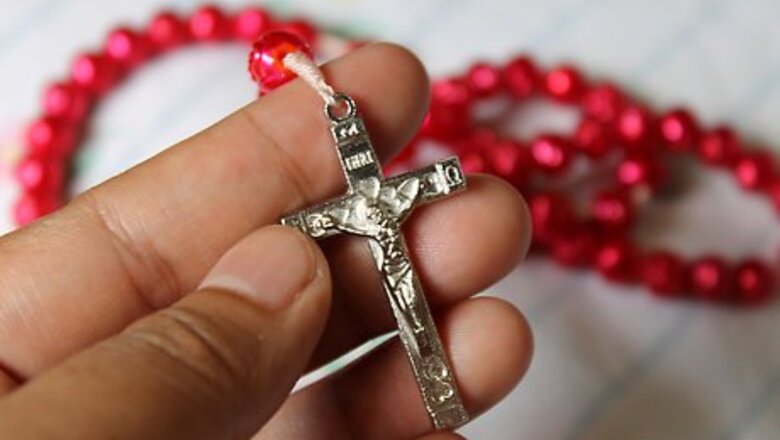
views
Reciting the Holy Rosary

Begin by holding the crucifix in your fingers while making the Sign of the Cross. The rosary is said by traveling around the loop of beads, stopping at each one, and saying a prayer. Typically, if someone is going to say the whole rosary, rather than just a section of it, s/he starts with the crucifix at the "bottom".

Say the Apostle's Creed. This prayer is a statement of Christian belief, one that essentially summarizes the things that all Christians believe, including the existence of God, Jesus, the Holy Spirit, and the Resurrection. The words of the Apostles' Creed are: "I believe in God, the Father Almighty, Creator of heaven and earth; and in Jesus Christ, His only Son, our Lord: Who was conceived by power of the Holy Spirit, born of the Blessed Virgin Mary; suffered under Pontius Pilate, was crucified, died and was buried. He descended into hell; the third day He rose again from the dead; He ascended into heaven, is seated at the right hand of God the Father Almighty; from thence He shall come to judge the living and the dead. I believe in the Holy Spirit, the Holy Catholic Church, the communion of Saints, the forgiveness of sins, the resurrection of the body, and life everlasting. Amen." When Protestants say the Apostle's Creed, they usually change the meaning of the word "Catholic" in the line "I believe in the Holy Spirit, the holy Catholic Church, the communion of saints..." to reflect the concept of universality, rather than the actual earthly institution of the Roman Catholic church.
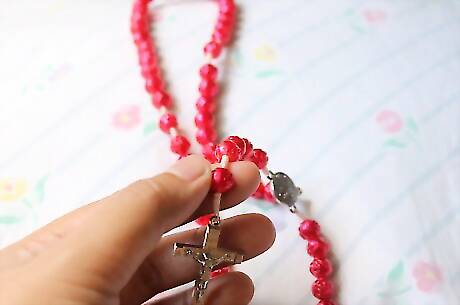
Move to the first bead after the crucifix and say the Lord's Prayer. Take the next bead in your fingers and say the Lord's prayer (also called the "Our Father"). This prayer was passed directly from Jesus to his disciples as a way of expressing devotion to God in heaven. The words of the Our Father are: "Our Father, Who art in Heaven, hallowed be Thy Name. Thy Kingdom come, Thy Will be done, on earth as it is in Heaven. Give us this day our daily bread, and forgive us our trespasses as we forgive those who trespass against us. And lead us not into temptation, but deliver us from evil. Amen."
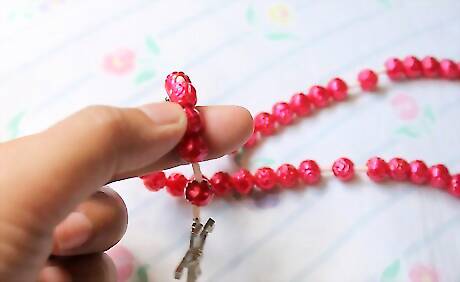
Move to the following group of three beads and say three Hail Marys. Next, say one Hail Mary for each of the next three beads, taking each bead in your fingers as you begin each prayer in succession. Traditionally, among Catholics, these 3 Hail Marys are offered to obtain an increase in the virtues of Faith, Hope and Charity and for the intentions of the Pope. The words of the Hail Mary are: "Hail Mary, full of grace, the Lord is with thee. Blessed art thou among women, and blessed is the fruit of thy womb, Jesus. Holy Mary, Mother of God, pray for us sinners, now and at the hour of our death. Amen." Some Protestants are hesitant to say the Hail Mary because it is offered to Mary, rather than God or Jesus. Though it's up to you to decide whether you want to say the Hail Mary or not, the many arguments put forth by members of the Catholic Church and various Protestant churches regarding the prayer's biblical basis may help you come to a decision. If you're reluctant to say the Hail Mary, know that some Protestant churches have their own versions of the rosary that omit this prayer.

Move to the chain or cord between the three Hail Mary beads and the next bead and say the Doxology. The Doxology (also called the "Glory Be to the Father" or "Gloria Patri") is a short hymn of praise exulting God, Jesus, and the Holy Spirit. The words of the Doxology are: "Glory be to the Father, and to the Son, and to the Holy Ghost. As it was in the beginning, is now, will be for ever. Amen." Often, if the Holy rosary is made from string, rather than chain, the Doxology will be marked with a thick or knotted section.
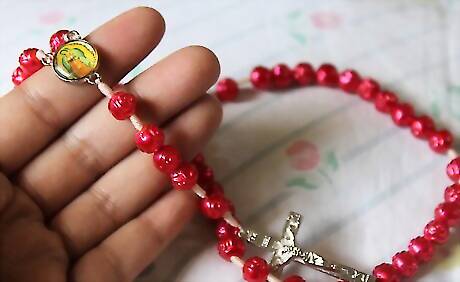
Proceed to the next bead and say an Our Father. This bead, which is usually a large and/or decorative medallion, marks the beginning of the first "decade" of the Holy rosary. The Holy rosary is divided into five decades, each composed of ten Hail Marys and separated from each other by Our Fathers.
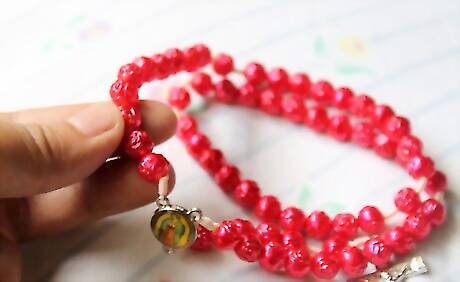
Say the first decade by reciting the "Hail Mary" for each bead in the decade. After the central bead, move counter-clockwise to the first group of ten beads. Say one Hail Mary for each bead in the decade, moving along the length of beads as you go. Note that many people say a single decade of the Holy rosary as a "short version" of the Holy rosary when they don't have time to say the entire Holy rosary.
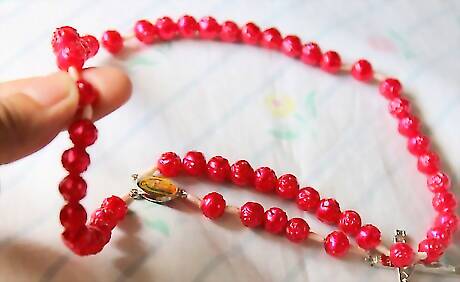
Proceed to the chain or cord separating the first decade from the next bead and say the Doxology. Optionally, you can also add the Fátima Prayer or/and the prayer for priests at this point; this is done without moving along the beads. The words of the Fátima Prayer are: "O my Jesus, forgive us our sins, save us from the fires of hell. Lead all souls to heaven, especially those in most need of Thy mercy." The words of the prayer for priests are: "O Jesus, our great High Priest, hear my humble prayers on behalf of your priests. Give them a deep faith, a bright and firm hope and a burning love which will ever increase in the course of their priestly life. In their loneliness, comfort them. In their sorrows, strengthen them. In their frustrations, point out to them that it is through suffering that the soul is purified, and show them that they are needed by the Church; they are needed by souls; they are needed for the work of redemption."
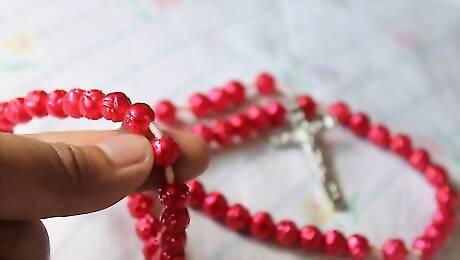
Proceed through the next decade, starting with the Lord's Prayer. You have successfully completed the first decade of the Holy rosary. Now, continue along the Holy rosary's beads, following the pattern of the first decade for each subsequent decade - one Our Father for the first bead, followed by a Hail Mary for each of the following ten beads, followed by a Doxology. Work your way along the rosary in this fashion until you have gone all the way around the chain of beads and are back at the large central bead.
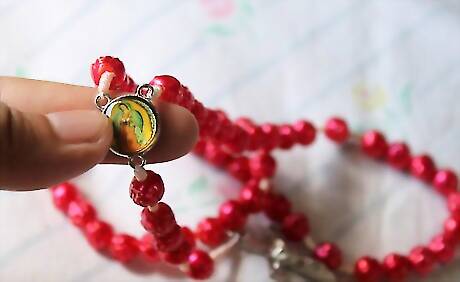
Reach the center medallion and say the Salve Regina. The Salve Regina is a hymn extolling the Blessed Virgin Mary similar to the Hail Mary. When you finish, make the Sign of the Cross to finish the Holy Rosary. Congratulations - you're done! The words of the "Salve Regina" Hail Holy Queen or are: "Hail Holy Queen, Mother of Mercy, our life, our sweetness, and our hope. To thee do we cry, poor banished children of Eve; to thee do we send up our sighs, mourning and weeping in this vale of tears. Turn then, most gracious advocate, thine eyes of mercy toward us, and after this, our exile, show unto us the blessed fruit of thy womb, Jesus. O clement, O loving, O sweet Virgin Mary! Pray for us, O Holy Mother of God, that we may be made worthy of the promises of Christ." Catholic tradition dictates that, if you like, you may add any prayers at the end of the Holy rosary that you like. These can be "official" prayers like the Our Father and Apostle's Creed or personal, improvised prayers from the heart.
Saying the Mysteries of the Rosary
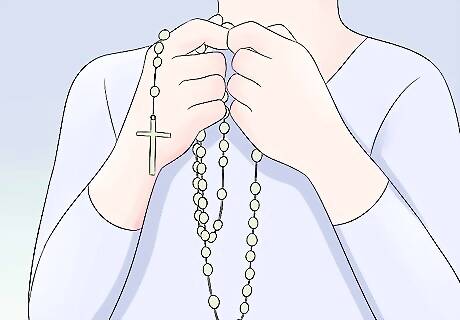
Use the mysteries to deepen your relationship with Christ and Mary. The Holy rosary is not just a prayer tool - it's also a way to reflect on important events in the lives of Jesus and Mary. Many serious Catholics choose to do so by reflecting on certain sets of mysteries as they pray the Holy rosary. Each set contains five mysteries grouped according to certain emotional themes. Individual mysteries are events in the life of Jesus and/or Mary that are taken from the Bible. Each mystery is associated with a certain religious virtue or "spiritual fruit" (e.g. charity, patience, etc.). By reflecting on these mysteries, someone who prays the Holy rosary can work to strengthen his or her personal relationship with Jesus and Mary, meditating on each event and the spiritual fruit associated with it. Note that not everyone who says the rosary chooses to do this, but anyone can. There are currently four sets of mysteries. The fourth mystery was added by Pope John Paul II in 2002; the others are centuries old. The sets of mysteries are: The Joyful Mysteries The Sorrowful Mysteries The Glorious Mysteries The Luminous Mysteries (added by Pope Saint John Paul II in 2002)
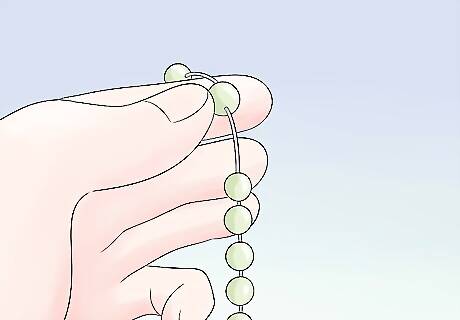
Reflect on one mystery for each decade of the rosary. To say the rosary in observance of one of the sets of mysteries, the person saying the rosary proceeds as normal from the crucifix through the first few beads. When s/he reaches the first decade, s/he meditates on the first mystery as s/he prays the Our Father, the ten Hail Marys, and so on. Upon reaching the second decade, s/he meditates on the second mystery as s/he prays. The person saying the rosary proceeds through the rosary in this fashion, reflecting on a different mystery for each decade. Each set of mysteries contains five mysteries - one for each decade of the rosary. Traditionally, a person reflects on a different set of mysteries for each day of the week. Below are more detailed instructions for each set.
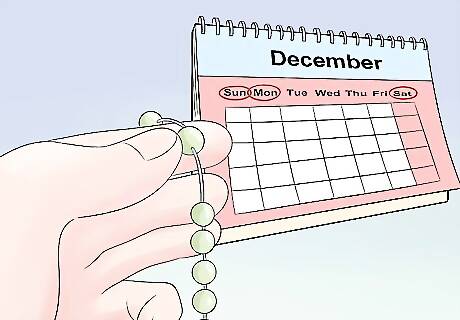
Reflect on the Five Joyful Mysteries on Mondays, Saturdays, and Sundays during Advent. The Joyful Mysteries are happy events in the lives of Jesus and Mary. These events occur fairly early in their respective stories - two even take place before the birth of Jesus. The Joyful Mysteries and the spiritual fruits associated with each are listed below: The Annunciation: Humility The Visitation: Charity The Birth of Our Lord: Poverty, or Detachment from the world The Presentation of Our Lord: Purity of heart; Obedience The Finding of Our Lord in the Temple: Piety
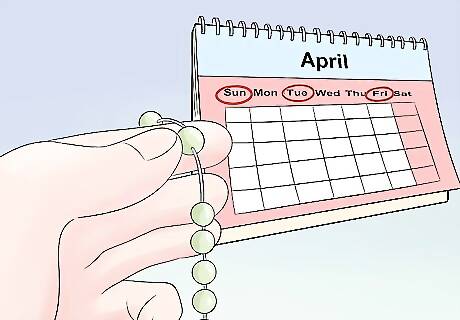
Reflect on the Five Sorrowful Mysteries on Tuesday, Friday, and Sundays during Lent. The Sorrowful Mysteries are sad events in the lives of Jesus and Mary (especially Jesus). These events are centered around the death of Christ by crucifixion. The Sorrowful Mysteries and the spiritual fruits associated with each are listed below: The Agony in the Garden: Contrition for our sins The Scourging at the Pillar: Mortification of our senses The Crowning with Thorns: Interior mortification The Carrying of the Cross: Patience under crosses The Crucifixion and Death of Our Lord: That we may die to ourselves

Reflect on the Five Glorious Mysteries on Wednesdays and Sundays in Ordinary Time. The Glorious Mysteries are events associated with the resurrection of Christ and the entry of Jesus and his mother into heaven. The Glorious Mysteries and the spiritual fruits associated with each are listed below: The Resurrection: Conversion of heart The Ascension: A desire for heaven The Coming of the Holy Ghost: The Gifts of the Holy Ghost The Assumption of our Blessed Mother into Heaven: Devotion to Mary The Coronation of our Blessed Mother: Eternal happiness

Reflect on the Five Luminous Mysteries on Thursdays. The Luminous Mysteries are the most recently created mysteries, having been added to Catholic tradition in 2002. These mysteries are events from Jesus' adult life and ministry. Unlike the other sets of mysteries, the Luminous Mysteries are not necessarily close to each other chronologically - while, for instance, the Sorrowful Mysteries all take place in sequence during a single short period, the Luminous Mysteries do not. The Luminous Mysteries and the spiritual fruits associated with each are listed below: The Baptism of Jesus in the Jordan: Openness to the Holy Spirit, the Healer. The Wedding at Cana: To Jesus through Mary. The understanding of the ability to manifest through faith. Jesus' Proclamation of the Kingdom of God: Trust in God (Call of Conversion to Messiah) The Transfiguration: Desire for Holiness The Institution of the Eucharist: Adoration



















Comments
0 comment